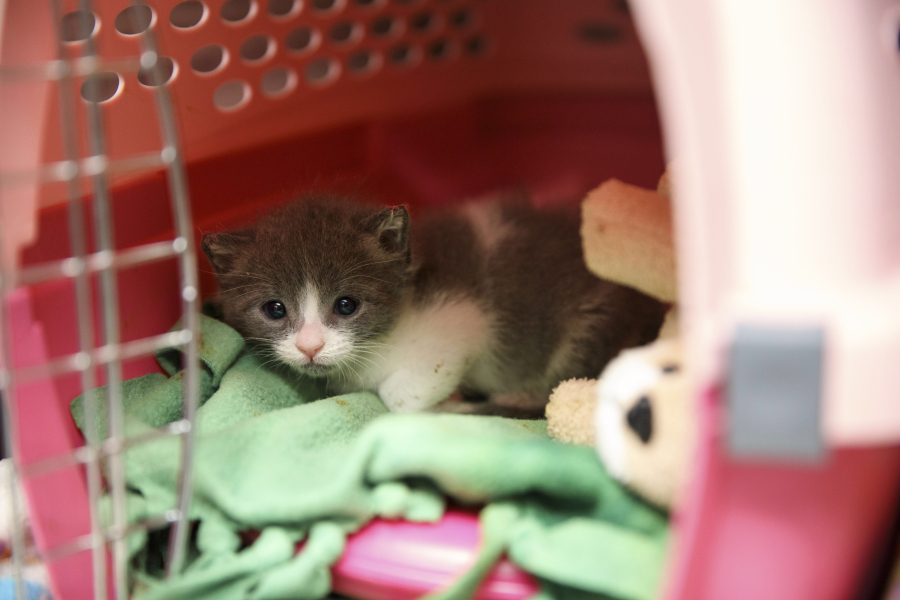LOS ANGELES — They are brought into shelters in crates, boxes and flower pots at this time of the year: Tiny, mewing kittens with eyes barely open, with pink, toothless mouths — and usually with no mother to nurse them.
And here’s what it takes to keep them alive: people to hand-feed formula through a syringe or tiny bottle every two to three hours around the clock, until the newborns are 4 weeks old. Most shelters do not have the resources to do this, so kittens younger than 8 weeks — the earliest age of adoption — are typically euthanized.
Not so at a stucco-sided facility on the north side of Los Angeles. Sophia Lim, one of its many volunteers, knows the routine. Hands clad in blue surgical gloves on a spring afternoon, she gingerly weighs a 4-week-old beige kitten named Osbourne on a small tabletop scale, then places him belly-down on her chest and holds a travel shampoo-sized bottle to his mouth. A few minutes later, she moves on to one of the other 81 unweaned kittens that need to eat.
“Sometimes I can’t believe how many kittens come in here,” said Lim, a nurse who regularly drives 33 miles from her home to help keep baby cats alive.
The shelter in the Mission Hills area houses one of this city’s half-dozen neonatal kitten nurseries, all of which have sprung up in recent years as part of an ambitious bid to lower euthanasia rates at six municipal facilities. Before the effort began, in 2012, about 57 percent of animals left the shelters alive; that percentage, or “live save rate,” is now in the mid-80s. And the goal is to reach 90 percent by year’s end, which would make this the nation’s largest “no-kill” city — where only very ill or dangerous animals are put down.
The cat problem is not unique to Los Angeles, of course. Although shelter euthanasia rates are falling nationwide, felines, many of them young, still make up nearly 60 percent of animals killed, according to the American Society for the Prevention of Cruelty to Animals. Experts say that is partly because many cats are feral or “semi-owned” by people who feed but do not necessarily sterilize them, nor do they search at shelters when they go missing.
Yet while cats can be harder to place, one demographic is a clear exception — those between 8 weeks and about 5 months of age. So despite the incredible manpower kitten nurseries require, the idea is gaining traction among shelter experts, and operations are now found in cities including Austin and New York.
“It was clear that one of the best ways to raise our live save rate was to save these bottle babies,” said Brenda Barnette, the general manager of Los Angeles Animal Services.
Millions of strays roam the streets of this sprawling city, where sunshine makes outdoor living easier and the breeding season longer. In 2011, city shelters killed nearly 7,300 kittens, or about 8 of every 10 admitted.
The number of kittens euthanized was down to 2,642 last year, in part because of the nursery where Lin volunteers. It is in a public facility managed by the Utah-based Best Friends Animal Society, which partnered with the city to lead the no-kill campaign, and it pulls unweaned kittens from shelters across Los Angeles.
“If you invest in this population, you will see a return, because people want kittens,” said Matt Bershadker, the president and chief executive of the ASPCA, which runs the New York City nursery. “There’s an outlook for these animals.”
The Mission Hills nursery is just one quiet section of a fairly large facility, but the patients need little space. The tiniest — which on this day included 2-week-old siblings named Leroy, Lucas, Lacy and Loraine — snooze on blankets spread over heating pads in rectangular fish tanks, cuddling up to stuffed animals that stand in for missing mothers.
Older litters are in cages, and there are generally a few adult females lounging with their kittens in a “mommy and me” room.
The staff took in 23 kittens in January but 646 in May. Things will get more crowded daily for the next several months as more cats breed — a time of year people in the animal-shelter world sometimes call “kitten mountain,” in reference to the bell curve of intake between spring and late fall. And by December, the annual count is expected to surpass a record 3,000. Some 2,600 kittens came through in 2016.
Helping keep them fed is a volunteer corps of about 80, who work two-hour shifts weighing kittens, taking notes on their eating habits and mixing gruel for those more than a month or so old.
“This is really a triage center,” said Marc Peralta, executive director of Best Friends’ Los Angeles office. The organization spends about $6 million a year on the nursery and other programs to lower the city’s euthanasia rates.
Several hundred “fosters” care for kittens at home. Lim, who was in the midst of a week off from work last month, said she had two kittens at her house. She’d fed them at 1 a.m. and again four hours later.
“So this is how I spend my vacation,” she laughed.



